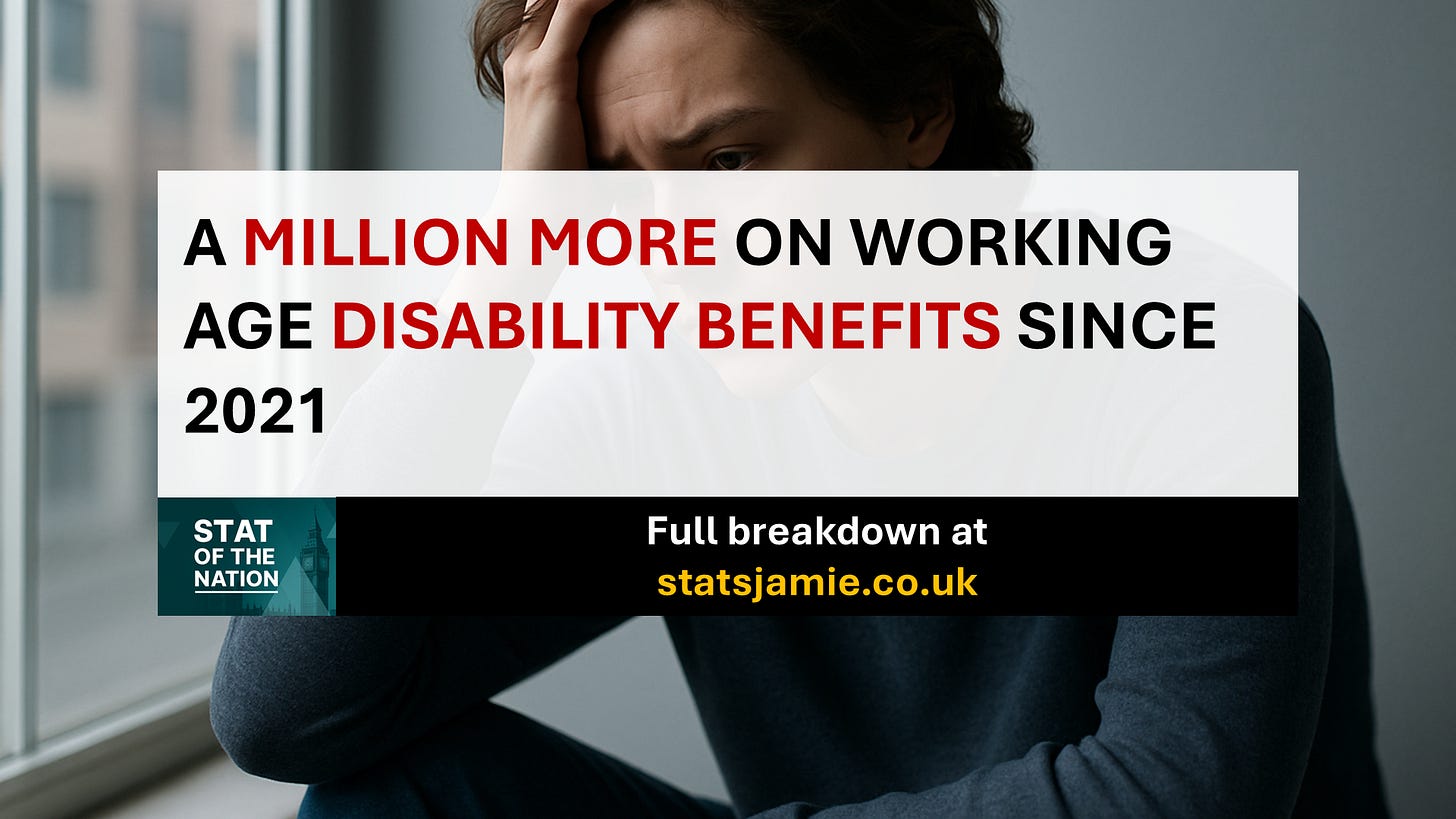A System Under Strain
Since July 2021, the number of Personal Independence Payment (PIP) claimants has risen from 2.8 million to 3.8 million. That’s an astonishing increase of one million people in just three years.
The most striking feature is where that growth is happening. Psychiatric conditions, including anxiety, depression, and other mood disorders, have surged. In 2021, there were just under 1 million claimants in this category; today, the figure stands at 1.5 million — a 50% rise in a very short space of time. That equates to around 446 new awards every single day over the past three years.
Among the total number, 333,000 are young people aged 16–24, up from 200,000 in 2021. At the very stage of life when they should be entering the workforce and building their futures, hundreds of thousands are instead beginning adulthood on the welfare system.
This isn’t a statistical quirk — it marks a fundamental shift in how Britain is dealing with mental health, work, and welfare.
What Is PIP?
Personal Independence Payment (PIP) is the main disability benefit for working-age adults in Britain. Introduced in 2013 to replace Disability Living Allowance, it helps people with the extra costs of living with a long-term health condition or disability. PIP has two parts — one for daily living and one for mobility — each paid at either a standard or enhanced rate, depending on how much a person’s condition limits their ability to perform these activities. Awards are based on how someone functions day to day rather than their diagnosis, usually decided through a points-based assessment with a health professional.
The Price We Are Paying
The immediate cost is financial. The total welfare bill for working-age people and children has now reached £141 billion a year. Add in state pensions, and the total social security budget stands at more than £316 billion. This is one of the largest single areas of government spending.
However, this money must come from somewhere. Every extra claimant means one of three things: higher taxes, more borrowing, or cuts to other public services. In reality, Britain is now experiencing all three.
Taxes are already at their highest level since the aftermath of World War Two. Borrowing remains stubbornly high, with debt at £2.91 trillion — £52,000 for every man, woman and child. Meanwhile, frontline services, ranging from schools to policing to road maintenance, are under constant pressure, in part because a significant portion of the budget is diverted to welfare.
This is the hidden link between benefit dependency and everyday frustrations: your higher tax bill, your local services stretched thin, and your children’s education squeezed are all tied to the rise in social security spending.
What’s Gone Wrong?
Some have blamed the pandemic for the rise, but that doesn’t fully explain what’s happening. The UK’s increase in disability and health-related benefit claims has been exceptionally sharp — far steeper than in most comparable countries. Research from the Institute for Fiscal Studies found that Britain has seen one of the largest rises in health-related welfare claims among advanced economies, while in many other countries the numbers have remained stable or even declined.
This suggests something deeper is broken in how Britain handles mental health, welfare, and work.
NHS backlogs mean people with genuine mental health conditions are left waiting months or years for treatment. Instead, the state moves many of them onto benefits to fill the gap.
Light-touch assessments — often done over the phone — mean many awards are granted with little scrutiny and are rarely reviewed.
Medicalising normal life: feeling anxious, stressed or low has become pathologised. Of course, some people need support — but the line between normal hardship and disabling illness has become dangerously blurred.
The resilience gap: the sharp rise among younger claimants suggests a cultural shift. Too many young people are leaving education unprepared for setbacks and rejection, finding benefits easier than work.
Limited routes back to work: while a minority of PIP claimants remain employed, the majority are not. For many, the system acts as a long-term substitute for proper treatment and rehabilitation, rather than a bridge back into the workforce.
The Consequences of Inaction
The dangers of doing nothing are huge. Economically, it means a shrinking base of taxpayers supporting a growing base of claimants. That is not sustainable. The more people we lose to long-term dependency, the weaker our productivity and growth become.
For society, it risks creating a lost generation. Hundreds of thousands of young people are being written off before they’ve even had the chance to contribute. That is a tragedy both for them and for the country.
And here’s where government policy is adding fuel to the fire. The rise in National Insurance contributions has made it more expensive for businesses to hire, particularly younger workers. As a result, fewer young people are entering the labour market. That is a double blow: not only does it leave more without the structure and purpose of work — fuelling anxiety and depression — but it also increases the likelihood they end up on benefits. Government action, far from improving wellbeing, is actively making it worse for Britain’s next generation.
For ordinary families, this all comes back as higher taxes and weaker services. Every extra pound absorbed by the benefit system is a pound not available for schools, hospitals, or policing. And for individuals, it means we are consigning too many to lives of dependency and low expectations, when they deserve better.
Where Do We Go From Here?
The answer is not to slash support for people in genuine need. It is to fix the system so that benefits are a temporary safety net — not a permanent lifestyle.
Invest in treatment, not just payouts: timely access to therapy and support can get people back on their feet, rather than locked into dependency.
Build resilience through education: young people need to be prepared for real life, with all its setbacks and challenges, not shielded from them.
Rebalance the welfare system: support should be there for those who truly cannot manage, but it cannot replace the role of work in people’s lives.
The Big Picture
Since 2021, an extra one million people have joined the disability benefit rolls. Half of that growth is down to psychiatric disorders. The consequences stretch far beyond welfare spending: higher taxes, heavier debt, weaker growth, and a generation of young people being written off before they’ve even started.
This isn’t about left or right. It’s about sustainability. Unless we change course, Britain risks locking itself into a spiral of dependency that will damage both our economy and our society for decades to come.
✍️ Jamie Jenkins
Thanks for reading Stat of the Nation. If you find these stats and insights useful, please share or subscribe to support my analysis.
I crunch the numbers so you don’t have to.
📲 Follow me here for more daily updates:









